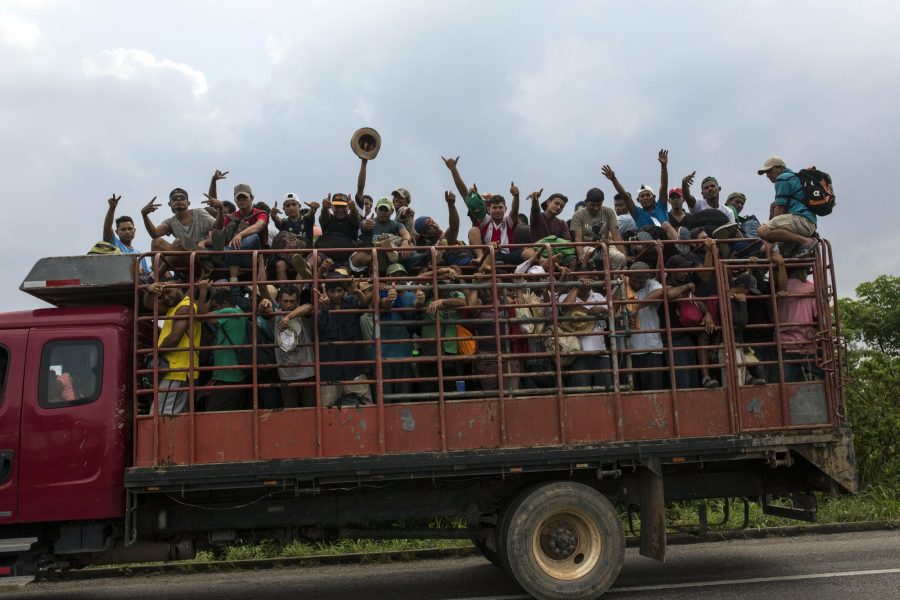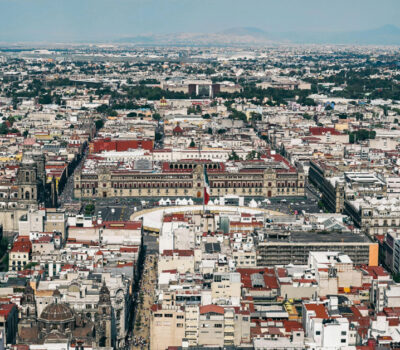Thousands of Central American migrants traveling in a caravan through southern Mexico resumed their journey toward the United States by hitchhiking and walking along highways on Saturday, after a governor reneged on a brief offer to provide dozens of buses to take them to Mexico City more quickly.
Gov. Miguel Angel Yunes announced Friday evening that authorities in the Gulf Coast state of Veracruz would be providing not only humanitarian assistance to the migrants but buses to leapfrog them to the country’s capital, three weeks after the migrants began their grueling journey.
“It is very important that they be able to move soon from Veracruz toward another place,” Yunes said in a video message. “For that reason, we also offered them transportation so that, if possible, tomorrow … they may be able to go to Mexico City or to the place they wish.”
Organizers of the caravan of about 4,000 migrants told its members that they would be leaving the town of Sayula around 5 a.m. Saturday in convoys of 10 buses for the 10- to 12-hour trip. A jubilant caravan coordinator told the group: “We are all going!”
But almost immediately afterward, Yunes released a second video saying that because Mexico City’s water system was undergoing maintenance and 7 million of its people would be without water over the weekend, it would not be correct to send the migrants there. The maintenance has been known about for weeks.
Migrants expressed surprise and disappointment at the decision before setting out by their own means for La Isla, a town about 43 miles (70 kilometers) away. A day prior, the migrants made a trek of 40 miles (65 kilometers) from Juchitan, Oaxaca, to Donaji, Oaxaca, and then even farther along to Sayula.
“They’re playing with our dignity. If you could have only seen the people’s happiness last night when they told us that we were going by bus and today we’re not,” said Gerardo Perez, a 20-year-old migrant who was tired from the trip.
Saira Cabrera, a 36-year-old migrant traveling with her husband and two children aged 7 and 13, said she was frustrated.
“It’s a letdown that first they told us yes, and then they said no. People are mad and confused,” she said.
Caravan organizers released a statement rejecting Yunes’ decision and demanding that he fulfill his offer of buses to Mexico City. The migrants’ request for buses to the capital were also ignored by the Mexican government days earlier when they were in Juchitan.
The latest reversal comes as Mexican authorities appear conflicted and divided over their approach to the caravan.
On Friday, another caravan of migrants — this time from El Salvador — waded over the Suchiate River into Mexico, bringing 1,000 to 1,500 people who want to reach the U.S. border.
That caravan tried to cross the bridge between Guatemala and Mexico, but Mexican authorities told those traveling in it they would have to show passports and visas and enter in groups of 50 for processing.
The Salvadorans expressed misgivings that they would be deported, so they turned around and waded across a shallow stretch of the river to enter Mexico.
Although police were present, they did not try to stop the migrants, who later walked along a highway toward the nearest large city, Tapachula.
Mexico is now faced with the unprecedented situation of having three caravans stretched out over 300 miles (500 kilometers) of highways in the states of Chiapas, Oaxaca and Veracruz, with a total of more than 6,000 migrants.
The first, largest group of mainly Honduran migrants entered Mexico on Oct. 19. Though that caravan once numbered as many as 7,000, it has shrunk significantly, although it has become difficult to give an exact number as migrants have advanced toward small towns any way they can.
Another caravan, also of about 1,000 to 1,500 people, entered Mexico earlier this week and is now in Mapastepec, Chiapas. That group includes Hondurans, Salvadorans and some Guatemalans. In addition, the government identified a smaller group of 300 Central American migrants walking further ahead, in the Gulf coast state of Veracruz.
Immigration agents and police have been nibbling at the edges of the two caravans farthest ahead.
A federal official who was not authorized to be quoted by name said 153 migrants in the second caravan were detained earlier in the week during highway inspections in Chiapas, a short distance from the Guatemalan border.
There has also been pressure on the main caravan. Federal police have been pulling freight trucks over and forcing migrants off, saying their habit of clinging to the tops or sides of the trucks was dangerous.
At other points along the route, police have forced overloaded pickups to drop off migrants and ordered passenger vans to stop helping with transportation.
With or without the Mexican government’s help, it remained unclear how many migrants would make it to the U.S. border; many days of scorching heat, constant walking, chills, rain and illness have taken their toll. Mexico’s Interior Department says nearly 3,000 of the migrants in the first caravan have applied for refuge in Mexico and hundreds more have returned home.
Ahead, they await more uncertainty.
President Donald Trump has ordered U.S. troops to the Mexican border in response to the caravans. More than 7,000 active duty troops have been told to deploy to Texas, Arizona and California.
Trump has also told the U.S. military mobilizing at the southwest border that if U.S. troops face rock-throwing migrants, they should react as though the rocks were rifles. He plans to sign an order next week that could lead to the large-scale detention of migrants crossing the southern border and bar anyone caught crossing illegally from claiming asylum.
Though some migrants clashed with Mexican police at a bridge on the Guatemala border, they have repeatedly denied coming with any ill intentions, saying they’re fleeing poverty and violence.
“We aren’t killers,” said Stephany Lopez, a 21-year-old Salvadoran with the first caravan.
__
Associated Press writer Peter Orsi in Mexico City contributed to this report.
Thousands of Central American migrants traveling in a caravan through southern Mexico resumed their journey toward the United States by hitchhiking and walking along highways . . .












